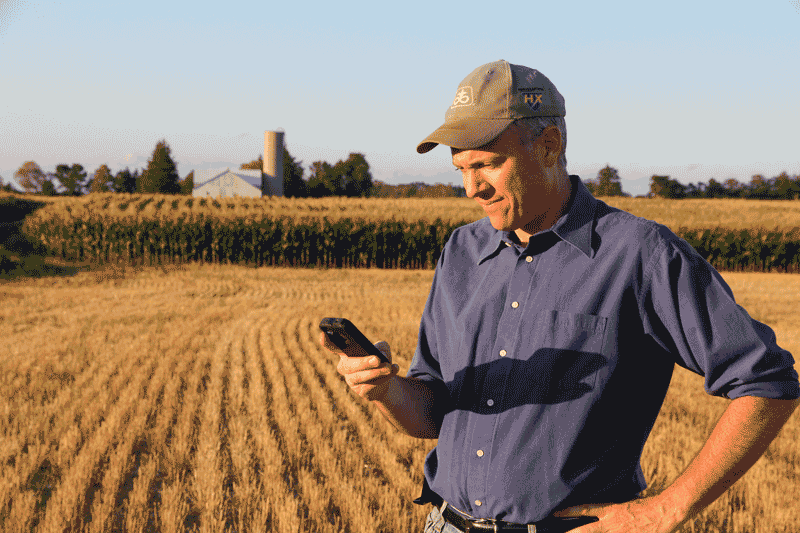Managing the mobile marketplace
HOW TO CHOOSE THE RIGHT PHONE FOR YOUR FARM
mobile technology is advancing the way farmers do business. Whether for real time market and weather updates or instant team communication, cell phones play a major role in today’s agricultural management. But unlike many business settings, growers rarely manage from behind a desk. The reality of barn and field environments where phones are subject to dust and dirt means rugged features need to be a high priority when choosing mobile tools.
“The challenge is that there is very little choice when it comes to a phone that is truly meant to stand up to what we are going to put the devices through,” says Andrew Campbell, who farms near Glencoe and runs Fresh Air Media.
PHOTO 1: ANDREW CAMPBELL USES A BLACKBERRY TORCH IN A SLEEVE CASE

mobile demographics
Ten months ago, a Farm Credit Canada (FCC) vision panel released survey results indicating that eight in ten Canadian farmers own a cell phone and nearly a third use a smartphone. Approximately two-thirds of these smartphone users reported owning Blackberry products while nearly one quarter used iPhone products.
But the technology industry is ever-changing and more recent studies in the US suggest farmers are adopting mobile tools at the same rate or more quickly than the general public. Fast forward to today and agricultural professionals like Campbell who regularly speak to growers at industry events estimate that one half of Canadian farmers are now using a smartphone and more are choosing iPhone and Android platforms over former Blackberry favourites.
brand options
When it comes to choosing a phone, growers have the option of over ten manufacturers and four operating systems: Blackberry, Apple, Android and Windows. So how do you choose?
The first step is to determine which features will enable you to get the most out of your management tool. Various types of screens, cameras and keyboards are determinants for some and voice, text and Internet data packages are a must for most buyers.
Push-to-talk (PTT) phones, which provide instant voice delivery, have traditionally been popular in agriculture. Bell recently launched the next-generation PTT network and released the Sonim XP5520 BOLT. Exclusively available in Canada, this phone is designed specifically for rugged work environments. It is built on the same platform that holds the Guinness World Record for the toughest phone and is submersible to two metres under water and equipped to handle two metre drops onto concrete.
Smartphones offer advanced Internet capabilities and the option of downloading a variety of apps. The selection of agricultural apps is quickly growing and is allowing producers to receive instant industry updates as well as manage inventory and other records on the go.
Wayne Black, a cash crop farmer and Sales Manager with Conestogo Agri Systems, Inc. from Huron County, is a smartphone advocate but says PTT may have an advantage over what existing smartphones offer. Although there are apps to record voice, the speed that some messages need to be delivered, such as from the combine to the grain buggy, may be improved with PTT.
PHOTO 2: WAYNE BLACK USES AN IPONE 4S PROTECTED BY AN OTTERBOX DEFENDER CASE

Despite the rugged phone options like the Sonim BOLT, many Ontario growers are passionate about their Blackberry, iPhone and Android products and in a recent Twitter poll, indicated that they have few concerns over damage. “I use an iPhone and I have not seen any situation where I have been concerned about the durability of the phone. I had an iPad that I took to the field and it never sustained any damage even after dropping on the floor of the tractor screen first,” says Black.
accessory essentials
But despite what may seem like an overwhelming number of phone options, agriculture technology experts are certain that the key purchasing decision is not actually what phone you buy but rather what you choose to protect it with.
Instead of investing time into comparing phone manufacturers, Campbell suggests putting more effort into buying a good case and screen protector. “Without a case, your phone is not likely to be around the farm for more than a year. It will help to keep the dust out while providing protection for when it hits the ground,” he says.
One of the most common choices for Ontario growers, including Black, is the OtterBox Defender series. He says he has yet to find a better product based on what it can do and the protection and warranty it offers.
In addition to a case and screen protector, Campbell also recommends investing in a Bluetooth device. “These devices are a good investment from a safety standpoint,” explains Campbell, who says they can also block out background noise from field equipment.
Both Black and Campbell agree that there has recently been a significant improvement in protection accessories available. “They eliminate any discussion over which phone is better able to withstand work duties. Simply buy the phone that does the job you want and then make sure there is a durable cover to protect it”, says Black. •






















